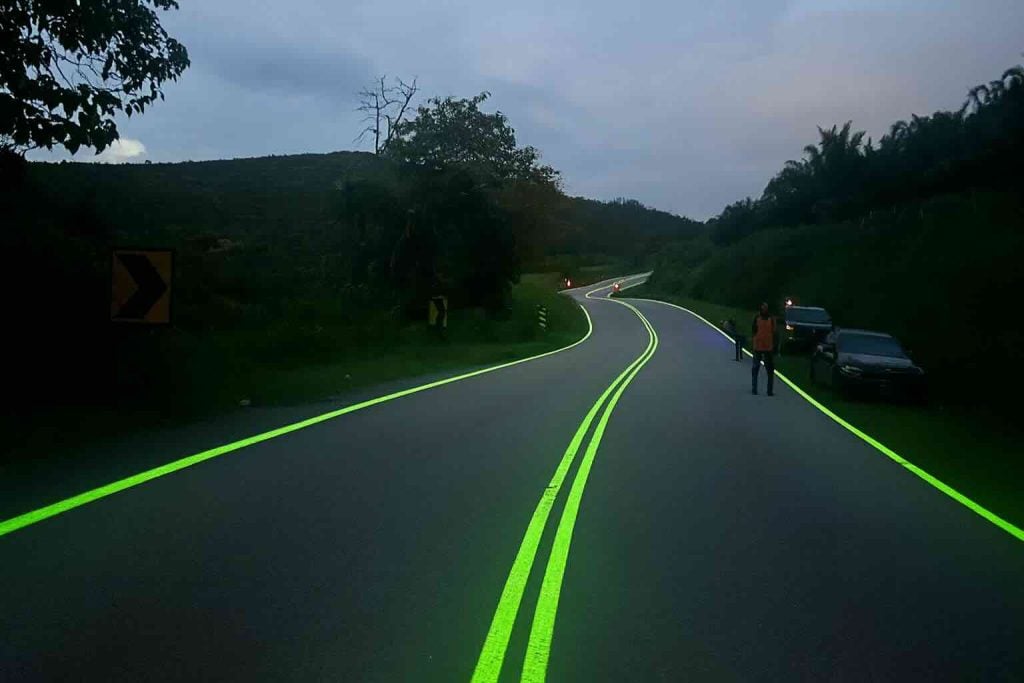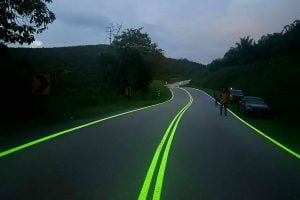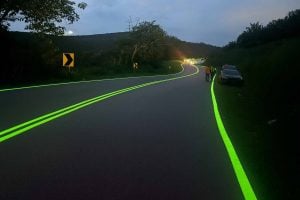In October 2023, a quiet two-lane road near Semenyih, Malaysia, began to glow after sunset — not from overhead streetlights, but from paint that absorbed sunlight during the day and emitted light at night. The 245-meter stretch, lined with photoluminescent markings, was part of a national experiment to improve visibility on rural roads often left in darkness due to limited infrastructure and frequent power outages.
With more than 6,000 road fatalities reported annually in Malaysia, many of them occurring on unlit rural routes, the idea felt like a timely innovation. The Public Works Department (JKR) launched the project as part of its initiative to enhance road safety and explore sustainable, energy-efficient alternatives to traditional lighting systems.
The pilot captured public attention almost immediately. Videos and images of glowing green road lines went viral across social media, with many Malaysians applauding the experiment. According to The Straits Times, drivers praised the markings for their clarity during heavy rain and fog — conditions that typically make conventional white paint nearly invisible.
But within a year, that early optimism faded. In November 2024, Deputy Works Minister Ahmad Maslan confirmed that the government would not proceed with broader implementation. The reason? Cost. As reported by Paul Tan’s Automotive News, the specialized paint costs RM749 per square meter — nearly 20 times the price of standard white road paint, which costs around RM40. That expense alone made the project unsustainable.
A Bright Idea for Dim Roads
The concept of glow-in-the-dark road markings isn’t unique to Malaysia. Countries like the Netherlands and Japan have experimented with similar technologies since the early 2010s. These systems rely on strontium aluminate-based paint — a compound capable of storing solar energy during the day and releasing it gradually after dark. The result is a soft, electricity-free glow that lasts several hours.
However, in most regions, such trials remained small-scale — often limited to bike paths, scenic highways, or short stretches of urban roads. Malaysia’s approach was different: a full-fledged test to determine whether photoluminescent paint could replace streetlights entirely in rural and low-income areas. The idea was simple — reduce reliance on electricity while improving road safety in the country’s most vulnerable regions.
During his site visit, Works Minister Alexander Nanta Linggi noted that the paint performed particularly well under difficult weather conditions. The lines stayed visible through rain, mist, and darkness — a major improvement in environments where lighting is unreliable. “If we can make this work, it could revolutionize how we approach rural infrastructure,” he said at the time.
On social media, enthusiasm was high. “Finally, Malaysian roads that shine!” joked one Instagram user, quoted by The Straits Times. Others praised the innovation as a potential “green” alternative to traditional streetlights, applauding the government’s willingness to try new approaches in public safety.
Budget Realities and Early Setbacks
Despite the glowing feedback, the financial and technical realities quickly became hard to ignore. According to Deputy Minister Maslan, trial sites in both Selangor and Johor failed to justify the high costs. Plans to expand the program — including 15 additional locations across Selangor and 31 pilot roads in Johor — were eventually scrapped after performance reviews revealed underwhelming long-term results.
The problem wasn’t just the paint’s steep price tag. Researchers at the Malaysian Institute of Road Safety Research (MIROS) raised concerns about its longevity in Malaysia’s humid, tropical environment. High rainfall, heat, and heavy traffic quickly wore down the coatings, reducing their glow time and effectiveness. These concerns aligned with a 2021 study in the International Journal of Pavement Research and Technology, which found that photoluminescent coatings in tropical climates can degrade in as little as 18 months — requiring costly reapplications.
Given these challenges, the Ministry concluded that continuing the project would divert resources from more immediate infrastructure needs. “We ran tests, but they did not meet the experts’ expectations,” Maslan told Parliament. “It was a good idea in theory, but not feasible in practice.”
As the pilot program wound down, JKR redirected its focus toward lower-cost safety solutions, such as high-visibility paint, solar-powered reflectors, and improved road maintenance — strategies with proven long-term value.
Shifting Public Mood and Political Priorities
When Malaysia first unveiled its glow-in-the-dark road, it symbolized a bold step toward modernizing national infrastructure. But public sentiment began shifting as the excitement faded and the realities of cost and maintenance surfaced. On Facebook and X (formerly Twitter), conversations turned critical. Users urged officials to focus on fixing potholes, repainting worn markings, and addressing chronic flooding on rural roads instead of funding experimental projects.
“Try driving at night during a downpour,” wrote one commenter quoted by The Straits Times. “It’s not futuristic paint we need — it’s proper drainage and flat roads.” Others argued that Malaysia’s transportation priorities should start with fundamentals, not flashy prototypes.
This change in tone reflects a broader challenge faced by governments worldwide: balancing innovation with practicality. High-tech experiments often attract attention but can be difficult to scale, especially in developing or climate-challenged regions. For Malaysia, the lesson was clear — innovation must serve long-term, affordable outcomes, not just headlines.
Globally, however, research into photoluminescent infrastructure continues. Scientists at the Delft University of Technology in the Netherlands and Japan’s National Institute for Land and Infrastructure Management are developing improved formulas that resist heat, rain, and UV degradation. Their goal is to make glow-in-the-dark coatings cheaper, tougher, and more environmentally sustainable — potentially paving the way for a second wave of experimentation.
For now, Malaysia’s glowing road stands as both a success story and a cautionary tale. It proved that creative thinking can capture public imagination, but it also highlighted the financial and environmental realities that determine whether innovation can survive in the real world. The road near Semenyih may no longer shine as brightly, but the vision it inspired — of safer, smarter, and more sustainable highways — continues to illuminate the future of transportation.


